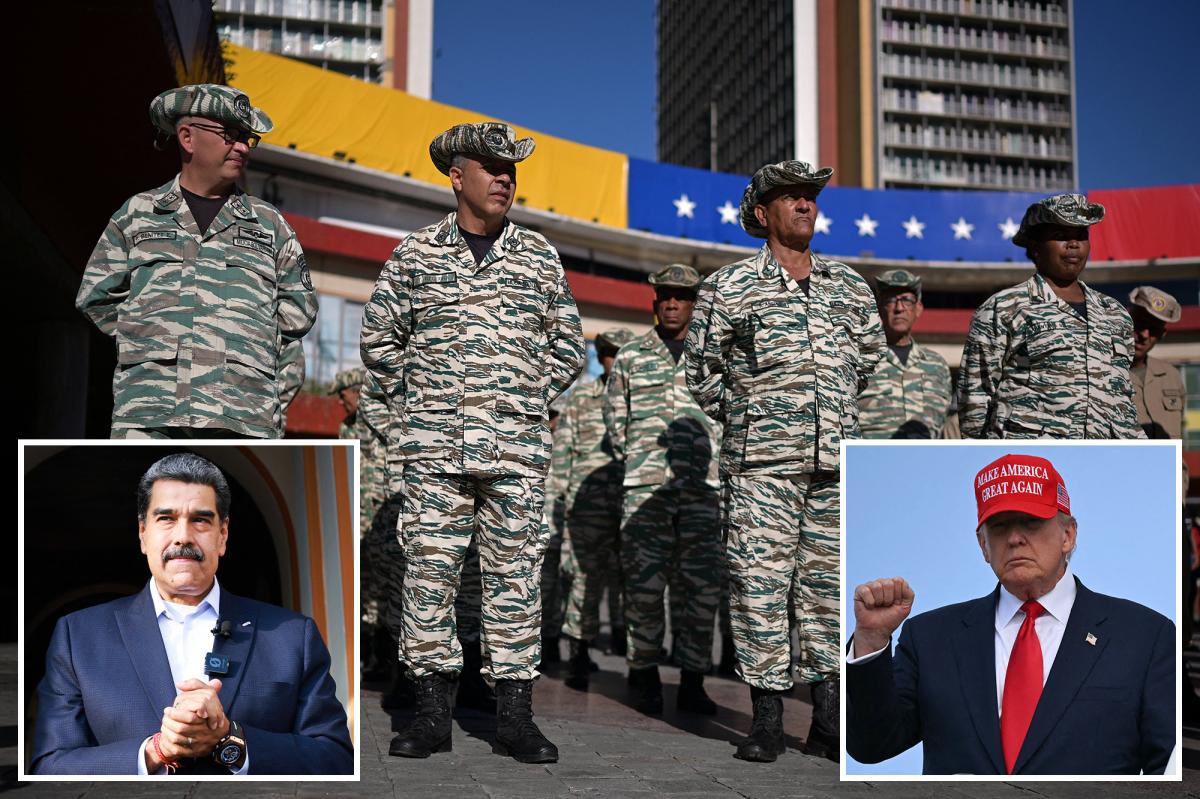The US is prepared to launch strikes on Venezuelan military bases as President Trump ramps up the pressure on the country’s narcoterrorist dictator, Nicolas Maduro, as the administration works to cut off the regime’s drug and criminal operations, The Post has learned.
The operation would aim to dismantle Maduro’s Cartel de los Soles command structure and target military installations that protect the Maduro regime’s drug trafficking activities, a source familiar with plans told The Post.
However, Trump on Friday told reporters on Air Force One that he had yet to make a decision on whether to pull the trigger.
Members of the Bolivarian Militia stand in formation during a military training, amid rising tensions with the U.S. in Caracas on Oct. 11. REUTERS
US officials have accused Cartel de los Soles of trafficking roughly 500 tons of cocaine to the US and Europe annually, working alongside gangs like Venezuela’s Tren de Aragua, Mexico’s Sinaloa Cartel and other criminal syndicates.
Trump first deployed warships to the waters around Venezuela in August, starting with seven warships carrying 4,500 troops. That number has since grown to roughly 10,000 — and the addition of an aircraft carrier currently in route to the region.
“The president is prepared to use every element of American power to stop drugs from flooding into our country and to bring those responsible to justice,” White House press secretary Karoline Leavitt told reporters when the deployments were first announced.
Those troops have since killed roughly 57 accused narcoterrorists in a series of 13 strikes on at least 14 drug boats, as of Friday.
President Trump is prepared to launch strikes on Venezuelan military sites as his crackdown on South American drug cartels heats up. AFP via Getty Images
While prior strikes in the region targeted the drug traffickers themselves, the coming attacks on land are intended to take out the cartel’s hierarchy, according to the Miami Herald, which first reported the story.
It comes after the Pentagon has at least twice deployed B-52 bombers to fly near the coast of Venezuela over the past two weeks on “show of force” missions.
While the strikes could come at any time — and Trump has previously said land strikes are authorized — it would be unlikely for the US to carry out such an operation while few key officials are in Washington.
Trump himself left the White House for Palm Beach, Fla. on Friday morning, and Secretary of War Pete Hegseth and Chief of the Joint Staff Air Force Gen. Dan Caine are on official travel.
Additionally, it is estimated to take at least another week for the USS Gerald R. Ford aircraft — coming from Europe — to reach the waters near Venezuela.
Venezuelan President Nicolas Maduro speaks during an official TV show on October 27, 2025. Venezuelan Presidency/AFP via Getty Images
Asked about the buildup of military forces near Venezuela and what the US could be planning to use them for on Friday, Hegseth said “we take the security of our hemisphere very seriously.”
“This surge is intentional and ongoing, and we hope that ultimately it clears out — changes the dynamic in our own hemisphere,” he told reporters. “So I’m obviously not going to talk about the particulars of why troops are where in every circumstance, but they’ve got a clear mission, and they’re executing it.”
As the news broke on Friday, the Kremlin — a close ally of the Maduro regime — issued a veiled threat pledging support for the Venezuelan dictator.
Start your day with all you need to know
Morning Report delivers the latest news, videos, photos and more.
Thanks for signing up!
“We support the leadership of Venezuela in defending its national sovereignty, taking into account the dynamics of the international and regional situation,” Russia’s Foreign Ministry wrote in a post to X.
“We stand ready to respond appropriately to the requests of our partners in light of emerging threats.”
While it’s unclear if Maduro himself is directly targeted in the coming strikes, officials have long suggested his days — at least in office — are numbered.
A supporter of Venezuelan President Maduro wears a t-shirt depicting US President Donald Trump and the slogan “Yankee go home” takes part in a rally against US military activity in the Caribbean, in Caracas on October 30, 2025. AFP via Getty Images
“Maduro is ending and a free and prosperous Venezuela is dawning,” a source close to the White House said. “Within days, Maduro will exist only in the past tense and in history’s judgment.
“The future Maduro and his enablers recklessly sought to strangle will finally inhale its first free breaths in decades. The regime is going down and the future is looking up.”
Rep. Maria Elvira Salazar (R-Fla.) also weighed in on the topic in a post to X on Friday, hinting that the strikes could come before Saturday.
“Maduro wanted an early Christmas, but Halloween always comes first,” she said.
Attorney General Pam Bondi has called Maduro “one of the world’s biggest drug traffickers,” highlighting his deep ties to organized crime and the threat he poses to national security.
This summer, she doubled the Justice Department’s reward for information leading to Maduro’s arrest to a record $50 million — twice as high as the bounty once placed on Osama bin Ladin’s head.
Other key regime figures, such as Interior Minister Diosdado Cabello and Defense Minister Vladimir Padrino López, have rewards worth up to $25 million for their arrests.

